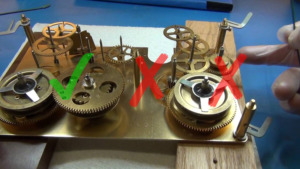Behind the Scenes, Part 5: In Real Life
Ever wondered how we design our games? This is the fifth post in a blog series about how we approach the challenge. (The fourth, in case you didn’t catch it, was our April Fool’s prank.)
So far, this blog series has focused on the more abstract aspects of game and puzzle design, but until you’ve produced some real-life objects, you haven’t created a real-life escape game. When it comes time to transform our drawings, mockups, code, and schematics into puzzles that are both fun and resilient, we keep four basic things in mind:
- Every puzzle is educational. (Even when you don’t want it to be.)
Each puzzle or activity in a game will teach the players something, whether that’s setting expectations for how difficult the room is, or teaching players that certain actions are “in-bounds.” If there is a key hidden under a vase, you can expect players to look under everything once they find that key, because that is now an in-bounds action. Unique to escape rooms is the risk of accidentally teaching players the wrong things. Putting something up high may seem like a good way to teach players that they need a tool to extend their reach, but it may also “teach” them to balance on their friend’s shoulders to grab that object they need.

Players should never feel like they are violating “the rules.” When necessary, our venue uses “STAFF ONLY” stickers to indicate fire alarms and other building infrastructure, as opposed to confusing in-theme signs like “HIGH-VOLTAGE” or “NO HUMANS ALLOWED.” We want to make sure players know what to believe. Similarly, puzzles should never feel like they’re breaking when they are being normally operated. Minimize the amount of force necessary, and never require a customer to bend anything. At best, a puzzle that feels like it’s breaking will keep a respectful person from solving it; and at worst, will teach a disrespectful person that it is okay to play rough. Which brings us to our next guideline…
- Puzzles must be robust.
Of course they should. But there are some non-obvious ways to help ensure that your props survive the test of hundreds of well-intentioned adults and children dropping, bending, and standing on them. These methods are most important when you’re building your own props from scratch, but if you’ve bought something premade that violates any of these principles, it might be worth your time to modify it to increase its lifespan:
- Avoid situations where dissimilar materials will be rubbing or touching. If you have one moving part made of metal, then anything it interfaces with should also be made of metal unless you’re ready for a lot of replacing and repainting.
- Minimize part count. A microcontroller is a part. A hinge is a part. A magnetic lock is a part. A screw is a part. You get the idea. Higher part count means more things that can go wrong, which means your prop is more likely to fail and you’re less likely to know exactly why.
- Do not rely on high precision. This includes sensitive alignment, friction, mechanical interference, and precise spacing between different parts. Hundreds of people are going to be touching and moving your props, and as a result, every object in your venue could move 1/16 of an inch in a random direction each game.

- The puzzle should be serviceable.
When constructing a prop or puzzle, keep in mind that, at some point, you will need to take it apart and put it back together. It may be 2 years down the road when that hinge fails or the LEDs don’t turn on anymore, and you will thank yourself if you can fix it with a single screwdriver instead of a Sawzall and a soldering iron. When possible, every puzzle should have a spare, and when not possible, every puzzle should have a “Plan B.” For high-tech puzzles that are difficult to service quickly, we also hardwire override switches so our operators can continue running games until they have a free minute to diagnose and fix the problem.

Serviceability isn’t just an issue when things go wrong—puzzles should also be easy to reset in between games. Objects that shouldn’t move (like furniture) should be bolted down. If a prop does need to move, you can make it easier to reset if it has a place where it “goes.” If possible, we make our puzzles reset themselves through electronic timeouts, or by making the final step of an analog puzzle involve returning it to its initial condition.
- The puzzle should be necessary.
Before you build a puzzle, draw two pictures of it: one picture in the initial “unsolved” state, and one picture in the final “solved” state. Can you imagine how someone would build that, even if you can’t build it yourself? For players, is there an obvious connection between the initial and final states, or are you connecting an arbitrary action to a mag-lock or combination? And is the process of solving the puzzle fun for a player? As designs go through different iterations, it can be easy to lose track of any one of these questions as you try to address the other two. Until the answer to all three of these is “yes,” you’re not ready to start building.

Just because an effect is technically possible doesn’t mean it’s a good idea. If you outsource your circuit design or code because you don’t understand it, then you make yourself very vulnerable to critical failures that your team can’t fix. There is also such a thing as too much magic — the logical leap or physical disconnect between an action and its outcomes — that makes players feel like they’re not in control.
Ultimately, the process of solving a puzzle should be empowering and engaging. If your puzzles are robust, clear, and consistent with the story and environment you have built for your players, they will leave the game with a feeling of accomplishment whether they “escaped” or not.
